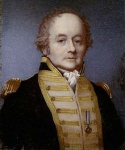HMS Cambridge (1755)

The launch of HMS Cambridge, left, in 1755
(with HMS Royal George shown fictitiously, right).
By John Cleveley the Elder.
HMS Cambridge was an 80-gun third-rate line, designed by Joseph Allin, built by M/shipwright John Holland until his death in the May of 1752. then by Thomas Fellows until his death in the March of 1753, Thomas Slade until August 1755. She was finally completed by Adam Hayes at Deptford Dockyard to the draught specified by the 1745 Establishment as amended in 1750, and launched on 21 October 1755.
History
GREAT BRITAIN
Name:
HMS Cambridge
Ordered:
12 July 1750
Builder:
Deptford Dockyard
Laid down:
29 August 1750
Launched:
21 October 1755
Commissioned:
17 January 1756
Fate:
Broken up in July 1808
Notes:
- Participated in:
- Capture of Havana, 1762
General characteristics
Class and type:
1750 amendments 80-gun third rateship of the line
Tons burthen:
1,615 long tons (1,640.9 t)
Length:
166 ft (50.6 m) (gundeck)
Beam:
47 ft (14.3 m)
Depth of hold:
20 ft (6.1 m)
Propulsion:
Sails
Sail plan:
Full rigged ship
Armament:
- 80 guns:
- Gundeck: 26 × 32 pdrs
- Middle gundeck: 26 × 18 pdrs
- Upper gundeck: 24 × 9 pdrs
- Quarterdeck: 4 × 6 pdrs
Early career.
She was commissioned in the October of 1755 as Flagship at Portsmouth in 1757.
Cambridge’s first captain was Sir Peircy Brett, who had previously been in command of HMY Royal Caroline. He was moved to the Cambridge in expectation of the outbreak of hostilities with France. With the outbreak of the Seven Years' War, Brett left the command in November or December 1756. He was replaced by Captain William Gordon. Gordon also did not spend long aboard Cambridge, leaving in April 1757 to take command of the newly launched HMS Princess Amelia. His successor was Captain Thomas Burnet, who was promoted to Post-Captain on 5 May. Cambridge then became CommodoreSir John Moore'sflagship on the West Indies Station.
Cambridge remained on this station for several years. In January 1759 Sir John was reinforced with a fleet dispatched from England under the command of Commodore Robert Hughes, consisting of eight two-deckers, a frigate and four bomb ketches. They were also transporting a number of troops under the command of General Peregrine Hopson. They were instructed to make attacks on French settlements in the West Indies. The first of these was a British expedition against Guadeloupe, for which Moore transferred his flag to HMS Woolwich. Cambridge, in company with HMS Norfolk and HMS St George, were ordered to attack the main citadel. The resulting attack lasted from nine in the morning until four in the afternoon, and succeeded in silencing the defences. After this success Commodore Hughes returned to Britain in June, taking Burnet and the Cambridge with him.
Later operations in the Caribbean.
The bombardment of Morro Castle on Havana – Lindsay is being rowed out from Trent to take command of Cambridge, right By Richard Paton (1717–1791)
Both Burnet and Cambridge were back in the West Indies later in 1759, Cambridge again serving as Commodore John Moore's flagship on the Leeward Islands Station. In 1760 Burnet was replaced by Captain William Goostrey, and Cambridge became the flagship of Rear Admiral Charles Holmes, who had replaced Moore and was commanding out of Jamaica. Cambridge then formed part of Sir George Pocock's fleet at the taking of Havana from the Spanish in 1762. During that action she, HMS Dragon and HMS Marlborough were ordered on 1 July to bombard and capture the Moro Fort. Cambridge's captain, William Goostrey, was killed by rifle fire from the fort and John Lindsay – then captain of HMS Trent – took over command whilst the battle was still in progress. Cambridge’s eventual casualties were 24 killed, including her captain, and 95 wounded.
Return to Britain.
By 1779 Cambridge was under the command of Captain Broderick Hartwell, and was serving as a guardship at Plymouth. Hartwell left the Cambridge in 1781 when he was appointed to be lieutenant-governor of Greenwich Hospital. On 23 December 1781 she was in company with Squirrel, Dunkirk, and Antigua at the capture of the Dutch ship De Vrow Esther.
During the Spanish armament of 1790 Cambridge became the flagship of Vice-Admiral Thomas Graves, and was commanded by Captain William Locker.
Recommissioned in April 1791 by Captain Thomas Hicks as Flagship of Rear Admiral Sir Richard Bickerton she again paid off in the September of that year.Fitted as a receiving ship at Plymouth in the December of 1792, she was reduced to harbour service in 1793 and as Flagship of Graves again. Then Rear Admiral Rowland Cotton in 1794. Cambridge continued as the Plymouth guardship, next coming under the command of Captain Boger and serving as the flagship of Vice-Admiral Richard King from 1795 till 1799.
She also transferred survivors from the wreck of HMS Colossus in 1798 from the brigs which had initially rescued them to HMS Castor.
In the May of 1799 under Captain john Wickey as Flagship of Vice Admiral Sir Thomas Pasley..
She was broken up at Plymouth in July 1808.








Bookmarks